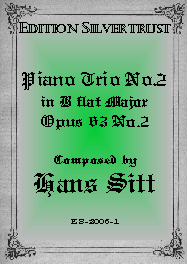Presents
Hans Sitt
Piano Trio No.2 in B flat Major, Op.63 No.2
 Many violinists have at least heard the name Hans
Sitt (1850-1922), probably because, among other things, he was, during his
lifetime, regarded as one of the foremost teachers of violin. Most of the
orchestras and conservatories of Europe and North America then sported personnel
who numbered among his students. He held the august position of Professor of
Violin at the Leipzig Conservatory from 1883 on, and authored several important
studies for that instrument, some of which are still used. Born in Prague, Sitt’s father was a prominent violin maker there. Hans’ musical talent
manifested itself early and from all accounts, he could easily have enjoyed the
typical career of a “wunderkind” had his parents chosen to exploit him, but they
wisely refused this course. Instead, he was allowed to have a normal life and
received a regular education at a gymnasium (high school) before being sent to
the Prague Conservatory where he studied violin and composition. Subsequently,
he pursued a successful solo career for a short time before being appointed
concertmaster of the Breslau Opera Orchestra at age 17, the first of many such
appointments. In addition, he was a conductor of repute holding
positions with orchestras in France, Austria and Germany.
Many violinists have at least heard the name Hans
Sitt (1850-1922), probably because, among other things, he was, during his
lifetime, regarded as one of the foremost teachers of violin. Most of the
orchestras and conservatories of Europe and North America then sported personnel
who numbered among his students. He held the august position of Professor of
Violin at the Leipzig Conservatory from 1883 on, and authored several important
studies for that instrument, some of which are still used. Born in Prague, Sitt’s father was a prominent violin maker there. Hans’ musical talent
manifested itself early and from all accounts, he could easily have enjoyed the
typical career of a “wunderkind” had his parents chosen to exploit him, but they
wisely refused this course. Instead, he was allowed to have a normal life and
received a regular education at a gymnasium (high school) before being sent to
the Prague Conservatory where he studied violin and composition. Subsequently,
he pursued a successful solo career for a short time before being appointed
concertmaster of the Breslau Opera Orchestra at age 17, the first of many such
appointments. In addition, he was a conductor of repute holding
positions with orchestras in France, Austria and Germany.
Besides his pedagogical works, Sitt wrote several pieces for violin and orchestra, including six concertos and a number of sonatas for various instruments. Sadly, the only chamber music of his we have are two piano trios which were composed during the 1880’s. It is sad because these trios are of a type one does not often encounter: Works which present no technical difficulty to either the professional or the good amateur, but at the same time they are so well written that they deserve to be heard in concert. Quite often, one comes across works which may be, from a technical standpoint, without challenge, but the thematic material itself, or the treatment of the material, is of such a quality that the music is scarcely of use beyond home music making. While Sitt’s trios are not massive chamber works which attempt to “scale the heights” neither are they trivial. Sitt is a master of the genre. The writing for all three instruments leaves little to be desired, each is exploited to its best advantage. There is no doubt that we are listening to Central European romantic music written between 1860—1890, but the melodic ideas are fresh and worthwhile.
Piano Trio No.2 in B Major, Op.63 No.2 is the more serious of the two. The opening theme to the first movement, Allegro, brought forth first by the strings alone is clearly heroic in nature and shows the influence of Brahms without being imitative. The second theme is sadder and more reflective. Unlike his first trio where he dispenses with a slow movement, here we find an Andante. The piano alone brings forth the lovely first subject and completely states it before the strings are brought in to heighten its beauty. An exciting animato section appears in the middle. The rollicking finale, Allegro vivace, has somewhat of a tarantella mood to it. A brilliant coda brings the work to an exciting close. We believe this is an excellent shorter trio which would be suited for performance where a somewhat shorter work is needed between two lengthier trios.
Parts: $24.95